Marketing Report: Analysis of Marketing Strategies and Demographics
VerifiedAdded on 2020/03/07
|6
|1360
|111
Report
AI Summary
This report presents a marketing analysis focusing on two key areas: estimating income distribution in New Zealand's North Island and examining worldwide demographic trends. The income distribution analysis outlines both qualitative and quantitative methodologies for data collection, including utilizing government websites and conducting surveys across the nine local government regions. The report details the survey design, sample size, and types of questions to be included. The second part of the report explores changing demographics, specifically the aging baby boomer generation and the rise of millennials. It discusses tailored marketing approaches for each demographic, emphasizing healthcare and financial management for baby boomers and sustainable living and digital marketing for millennials. The report also highlights industries that stand to benefit from these demographic shifts, such as healthcare, tourism, and real estate. References to key studies and reports are included to support the findings.
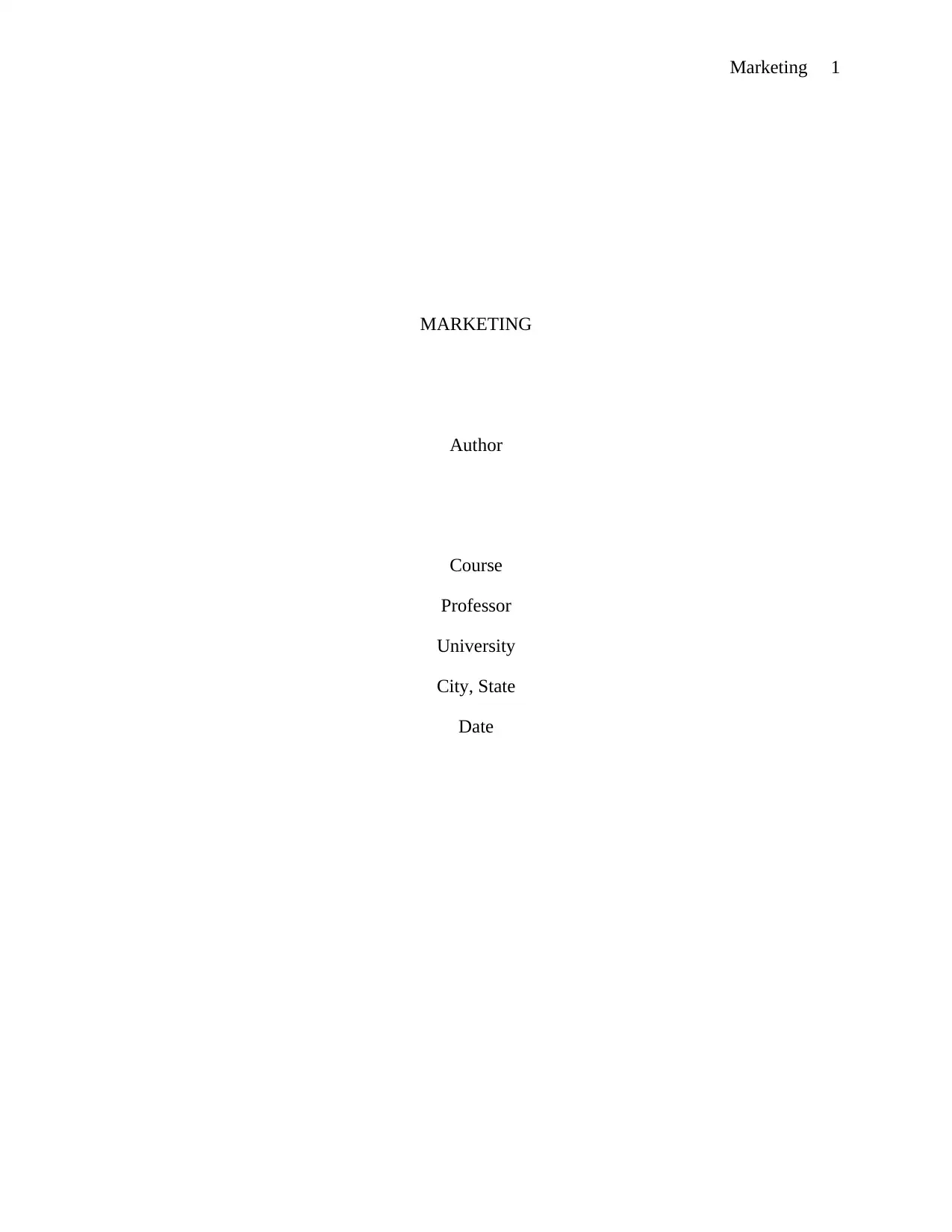
Marketing 1
MARKETING
Author
Course
Professor
University
City, State
Date
MARKETING
Author
Course
Professor
University
City, State
Date
Paraphrase This Document
Need a fresh take? Get an instant paraphrase of this document with our AI Paraphraser
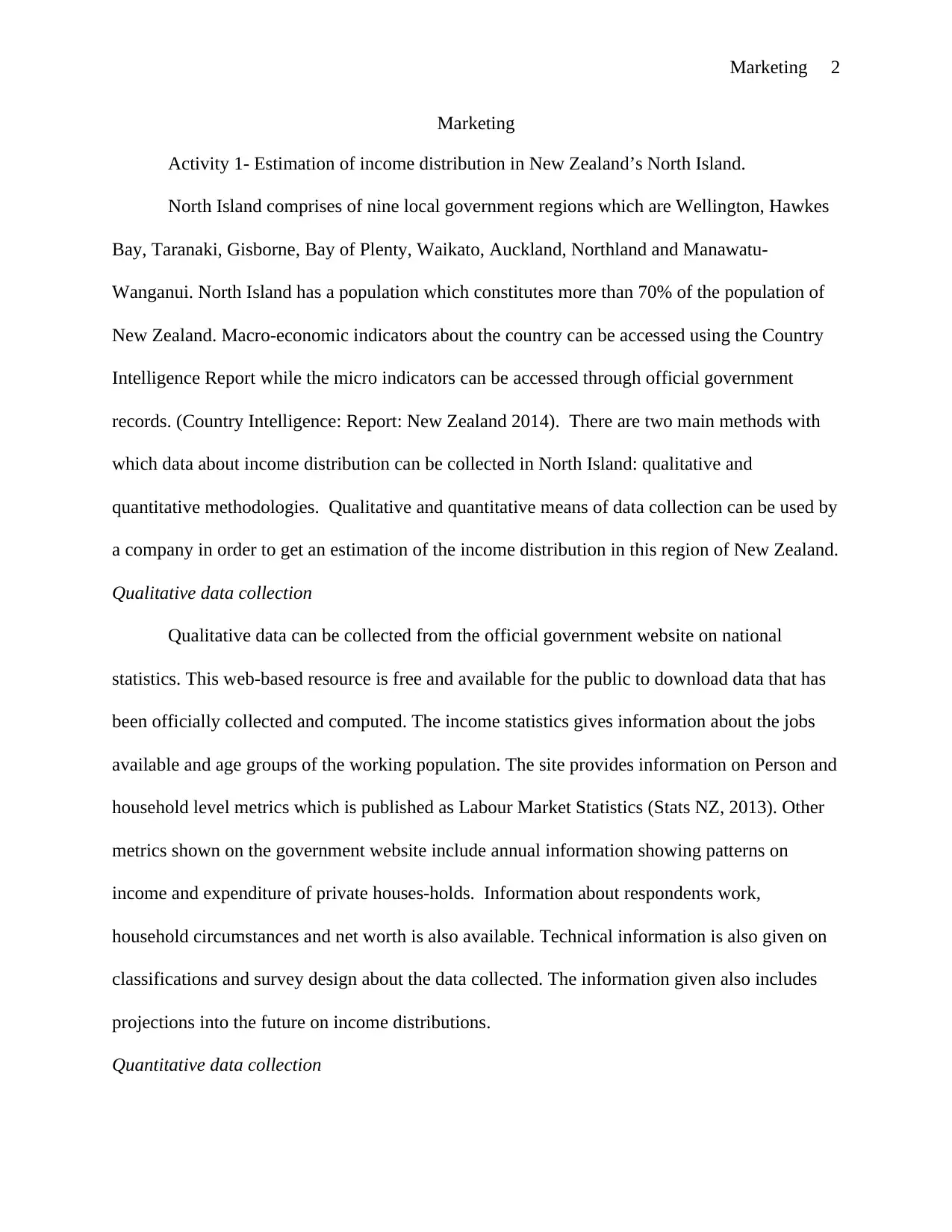
Marketing 2
Marketing
Activity 1- Estimation of income distribution in New Zealand’s North Island.
North Island comprises of nine local government regions which are Wellington, Hawkes
Bay, Taranaki, Gisborne, Bay of Plenty, Waikato, Auckland, Northland and Manawatu-
Wanganui. North Island has a population which constitutes more than 70% of the population of
New Zealand. Macro-economic indicators about the country can be accessed using the Country
Intelligence Report while the micro indicators can be accessed through official government
records. (Country Intelligence: Report: New Zealand 2014). There are two main methods with
which data about income distribution can be collected in North Island: qualitative and
quantitative methodologies. Qualitative and quantitative means of data collection can be used by
a company in order to get an estimation of the income distribution in this region of New Zealand.
Qualitative data collection
Qualitative data can be collected from the official government website on national
statistics. This web-based resource is free and available for the public to download data that has
been officially collected and computed. The income statistics gives information about the jobs
available and age groups of the working population. The site provides information on Person and
household level metrics which is published as Labour Market Statistics (Stats NZ, 2013). Other
metrics shown on the government website include annual information showing patterns on
income and expenditure of private houses-holds. Information about respondents work,
household circumstances and net worth is also available. Technical information is also given on
classifications and survey design about the data collected. The information given also includes
projections into the future on income distributions.
Quantitative data collection
Marketing
Activity 1- Estimation of income distribution in New Zealand’s North Island.
North Island comprises of nine local government regions which are Wellington, Hawkes
Bay, Taranaki, Gisborne, Bay of Plenty, Waikato, Auckland, Northland and Manawatu-
Wanganui. North Island has a population which constitutes more than 70% of the population of
New Zealand. Macro-economic indicators about the country can be accessed using the Country
Intelligence Report while the micro indicators can be accessed through official government
records. (Country Intelligence: Report: New Zealand 2014). There are two main methods with
which data about income distribution can be collected in North Island: qualitative and
quantitative methodologies. Qualitative and quantitative means of data collection can be used by
a company in order to get an estimation of the income distribution in this region of New Zealand.
Qualitative data collection
Qualitative data can be collected from the official government website on national
statistics. This web-based resource is free and available for the public to download data that has
been officially collected and computed. The income statistics gives information about the jobs
available and age groups of the working population. The site provides information on Person and
household level metrics which is published as Labour Market Statistics (Stats NZ, 2013). Other
metrics shown on the government website include annual information showing patterns on
income and expenditure of private houses-holds. Information about respondents work,
household circumstances and net worth is also available. Technical information is also given on
classifications and survey design about the data collected. The information given also includes
projections into the future on income distributions.
Quantitative data collection
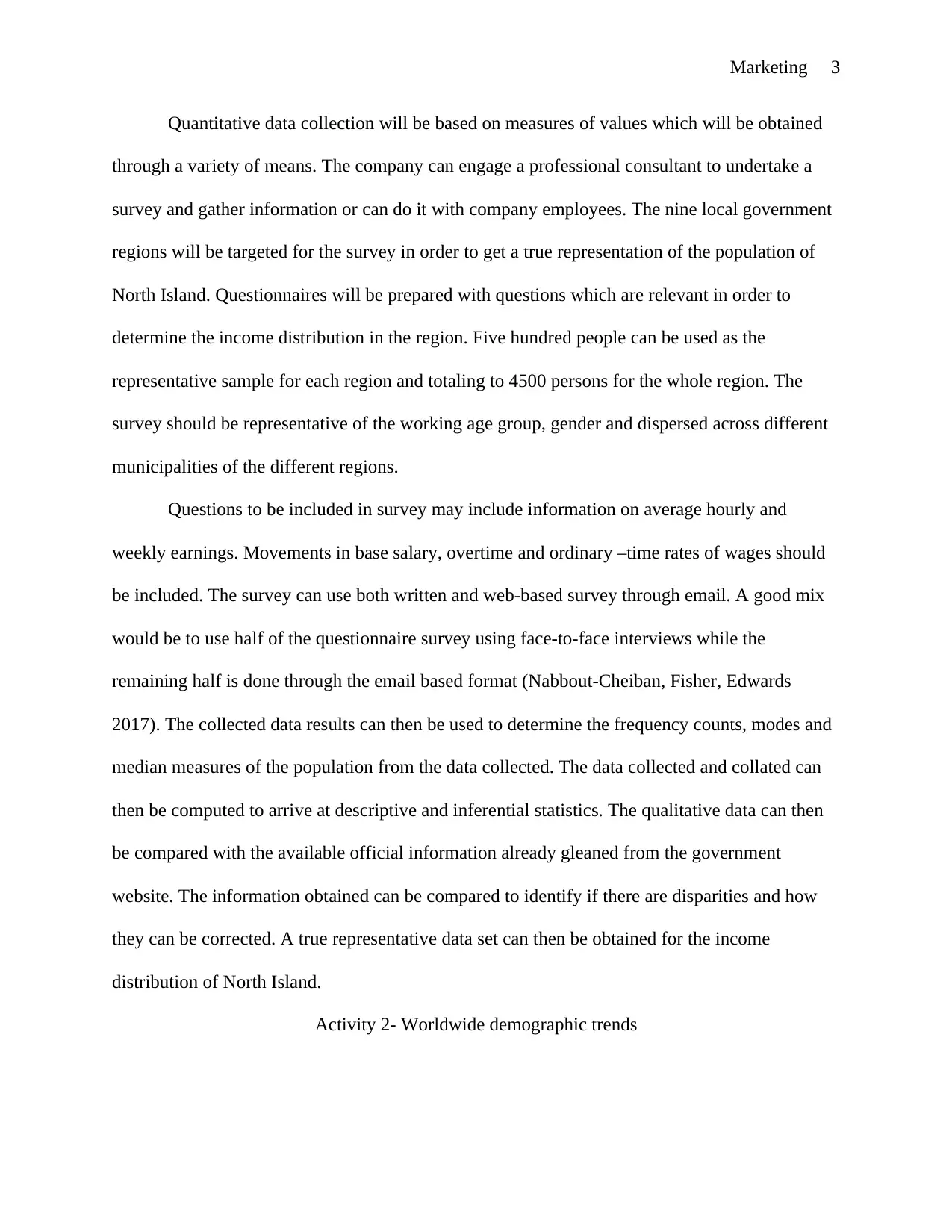
Marketing 3
Quantitative data collection will be based on measures of values which will be obtained
through a variety of means. The company can engage a professional consultant to undertake a
survey and gather information or can do it with company employees. The nine local government
regions will be targeted for the survey in order to get a true representation of the population of
North Island. Questionnaires will be prepared with questions which are relevant in order to
determine the income distribution in the region. Five hundred people can be used as the
representative sample for each region and totaling to 4500 persons for the whole region. The
survey should be representative of the working age group, gender and dispersed across different
municipalities of the different regions.
Questions to be included in survey may include information on average hourly and
weekly earnings. Movements in base salary, overtime and ordinary –time rates of wages should
be included. The survey can use both written and web-based survey through email. A good mix
would be to use half of the questionnaire survey using face-to-face interviews while the
remaining half is done through the email based format (Nabbout-Cheiban, Fisher, Edwards
2017). The collected data results can then be used to determine the frequency counts, modes and
median measures of the population from the data collected. The data collected and collated can
then be computed to arrive at descriptive and inferential statistics. The qualitative data can then
be compared with the available official information already gleaned from the government
website. The information obtained can be compared to identify if there are disparities and how
they can be corrected. A true representative data set can then be obtained for the income
distribution of North Island.
Activity 2- Worldwide demographic trends
Quantitative data collection will be based on measures of values which will be obtained
through a variety of means. The company can engage a professional consultant to undertake a
survey and gather information or can do it with company employees. The nine local government
regions will be targeted for the survey in order to get a true representation of the population of
North Island. Questionnaires will be prepared with questions which are relevant in order to
determine the income distribution in the region. Five hundred people can be used as the
representative sample for each region and totaling to 4500 persons for the whole region. The
survey should be representative of the working age group, gender and dispersed across different
municipalities of the different regions.
Questions to be included in survey may include information on average hourly and
weekly earnings. Movements in base salary, overtime and ordinary –time rates of wages should
be included. The survey can use both written and web-based survey through email. A good mix
would be to use half of the questionnaire survey using face-to-face interviews while the
remaining half is done through the email based format (Nabbout-Cheiban, Fisher, Edwards
2017). The collected data results can then be used to determine the frequency counts, modes and
median measures of the population from the data collected. The data collected and collated can
then be computed to arrive at descriptive and inferential statistics. The qualitative data can then
be compared with the available official information already gleaned from the government
website. The information obtained can be compared to identify if there are disparities and how
they can be corrected. A true representative data set can then be obtained for the income
distribution of North Island.
Activity 2- Worldwide demographic trends
⊘ This is a preview!⊘
Do you want full access?
Subscribe today to unlock all pages.

Trusted by 1+ million students worldwide
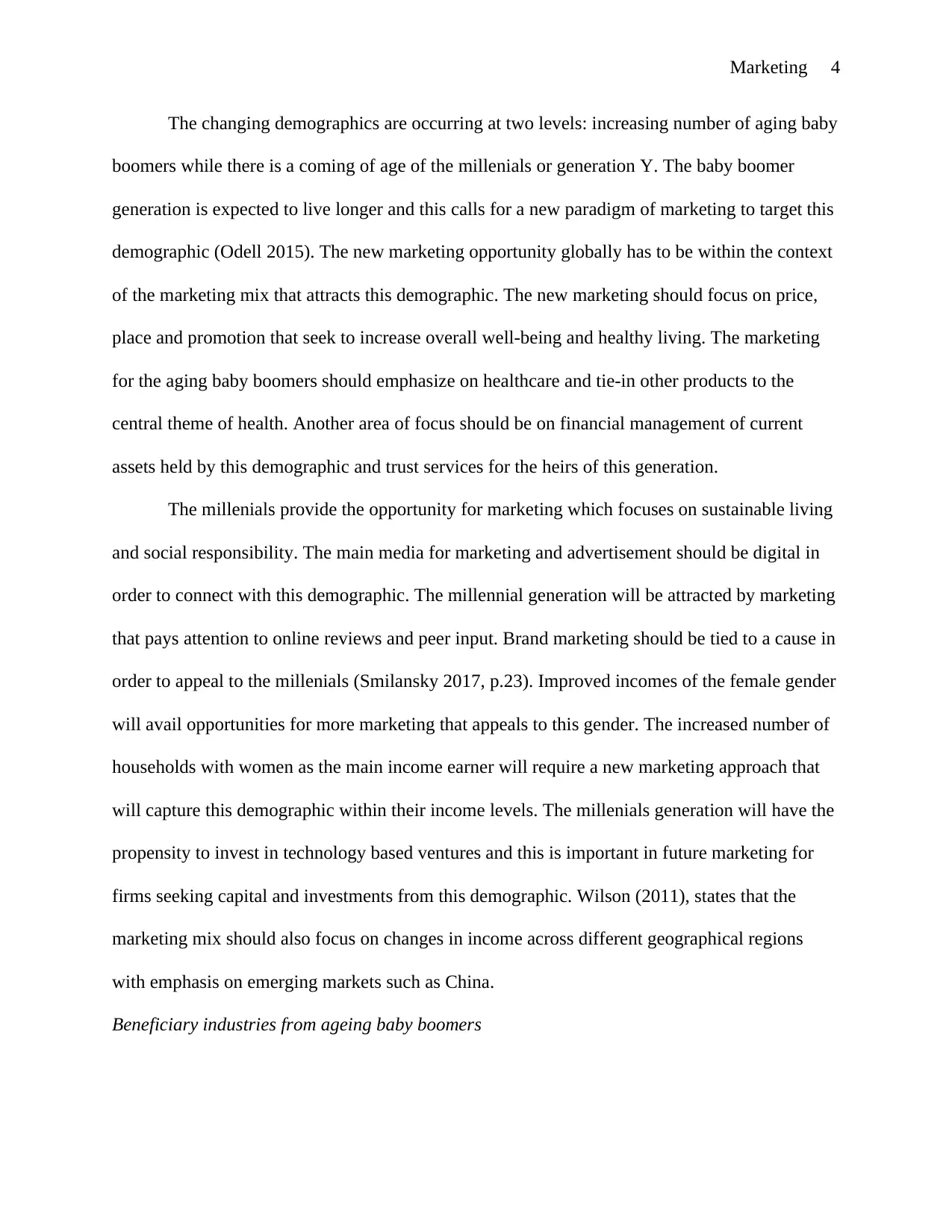
Marketing 4
The changing demographics are occurring at two levels: increasing number of aging baby
boomers while there is a coming of age of the millenials or generation Y. The baby boomer
generation is expected to live longer and this calls for a new paradigm of marketing to target this
demographic (Odell 2015). The new marketing opportunity globally has to be within the context
of the marketing mix that attracts this demographic. The new marketing should focus on price,
place and promotion that seek to increase overall well-being and healthy living. The marketing
for the aging baby boomers should emphasize on healthcare and tie-in other products to the
central theme of health. Another area of focus should be on financial management of current
assets held by this demographic and trust services for the heirs of this generation.
The millenials provide the opportunity for marketing which focuses on sustainable living
and social responsibility. The main media for marketing and advertisement should be digital in
order to connect with this demographic. The millennial generation will be attracted by marketing
that pays attention to online reviews and peer input. Brand marketing should be tied to a cause in
order to appeal to the millenials (Smilansky 2017, p.23). Improved incomes of the female gender
will avail opportunities for more marketing that appeals to this gender. The increased number of
households with women as the main income earner will require a new marketing approach that
will capture this demographic within their income levels. The millenials generation will have the
propensity to invest in technology based ventures and this is important in future marketing for
firms seeking capital and investments from this demographic. Wilson (2011), states that the
marketing mix should also focus on changes in income across different geographical regions
with emphasis on emerging markets such as China.
Beneficiary industries from ageing baby boomers
The changing demographics are occurring at two levels: increasing number of aging baby
boomers while there is a coming of age of the millenials or generation Y. The baby boomer
generation is expected to live longer and this calls for a new paradigm of marketing to target this
demographic (Odell 2015). The new marketing opportunity globally has to be within the context
of the marketing mix that attracts this demographic. The new marketing should focus on price,
place and promotion that seek to increase overall well-being and healthy living. The marketing
for the aging baby boomers should emphasize on healthcare and tie-in other products to the
central theme of health. Another area of focus should be on financial management of current
assets held by this demographic and trust services for the heirs of this generation.
The millenials provide the opportunity for marketing which focuses on sustainable living
and social responsibility. The main media for marketing and advertisement should be digital in
order to connect with this demographic. The millennial generation will be attracted by marketing
that pays attention to online reviews and peer input. Brand marketing should be tied to a cause in
order to appeal to the millenials (Smilansky 2017, p.23). Improved incomes of the female gender
will avail opportunities for more marketing that appeals to this gender. The increased number of
households with women as the main income earner will require a new marketing approach that
will capture this demographic within their income levels. The millenials generation will have the
propensity to invest in technology based ventures and this is important in future marketing for
firms seeking capital and investments from this demographic. Wilson (2011), states that the
marketing mix should also focus on changes in income across different geographical regions
with emphasis on emerging markets such as China.
Beneficiary industries from ageing baby boomers
Paraphrase This Document
Need a fresh take? Get an instant paraphrase of this document with our AI Paraphraser
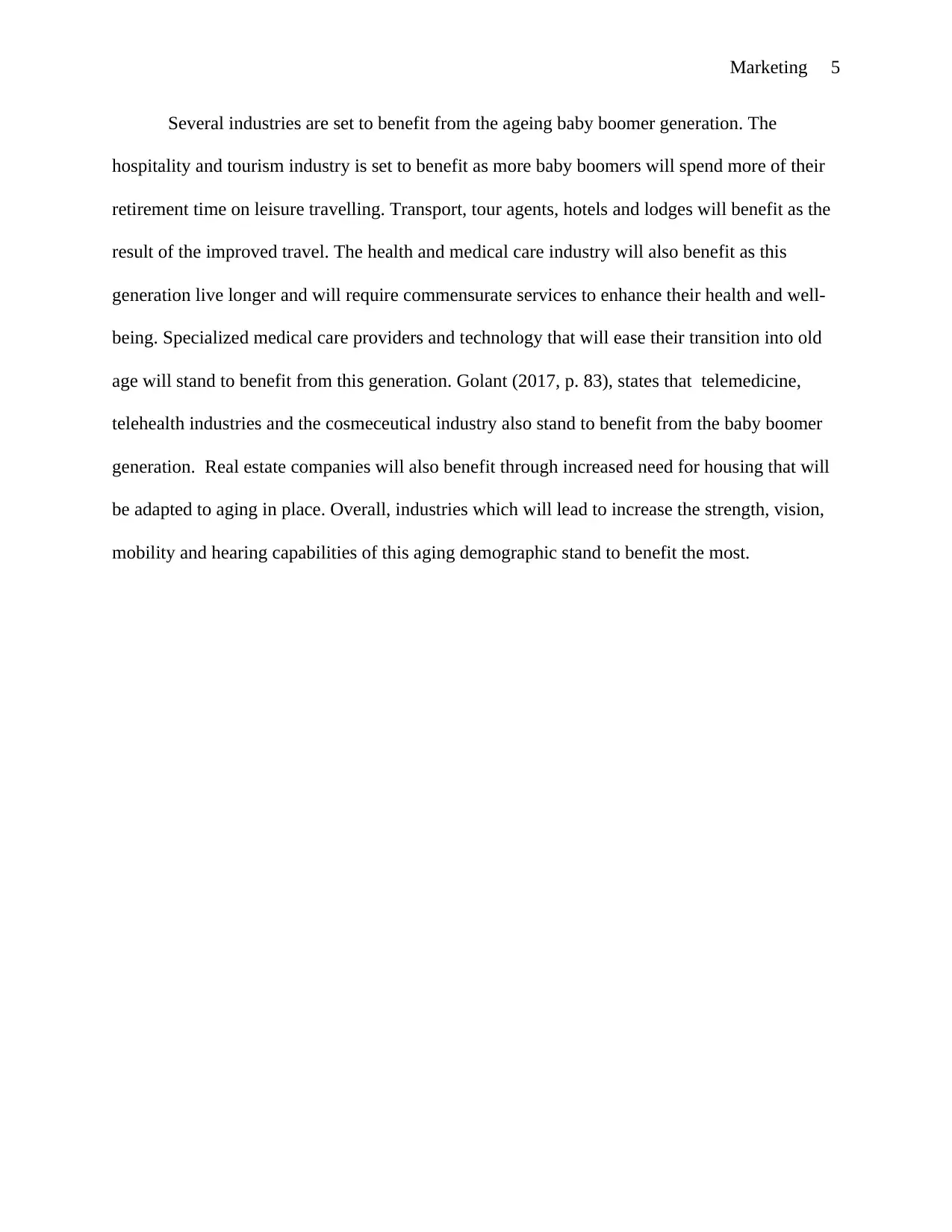
Marketing 5
Several industries are set to benefit from the ageing baby boomer generation. The
hospitality and tourism industry is set to benefit as more baby boomers will spend more of their
retirement time on leisure travelling. Transport, tour agents, hotels and lodges will benefit as the
result of the improved travel. The health and medical care industry will also benefit as this
generation live longer and will require commensurate services to enhance their health and well-
being. Specialized medical care providers and technology that will ease their transition into old
age will stand to benefit from this generation. Golant (2017, p. 83), states that telemedicine,
telehealth industries and the cosmeceutical industry also stand to benefit from the baby boomer
generation. Real estate companies will also benefit through increased need for housing that will
be adapted to aging in place. Overall, industries which will lead to increase the strength, vision,
mobility and hearing capabilities of this aging demographic stand to benefit the most.
Several industries are set to benefit from the ageing baby boomer generation. The
hospitality and tourism industry is set to benefit as more baby boomers will spend more of their
retirement time on leisure travelling. Transport, tour agents, hotels and lodges will benefit as the
result of the improved travel. The health and medical care industry will also benefit as this
generation live longer and will require commensurate services to enhance their health and well-
being. Specialized medical care providers and technology that will ease their transition into old
age will stand to benefit from this generation. Golant (2017, p. 83), states that telemedicine,
telehealth industries and the cosmeceutical industry also stand to benefit from the baby boomer
generation. Real estate companies will also benefit through increased need for housing that will
be adapted to aging in place. Overall, industries which will lead to increase the strength, vision,
mobility and hearing capabilities of this aging demographic stand to benefit the most.
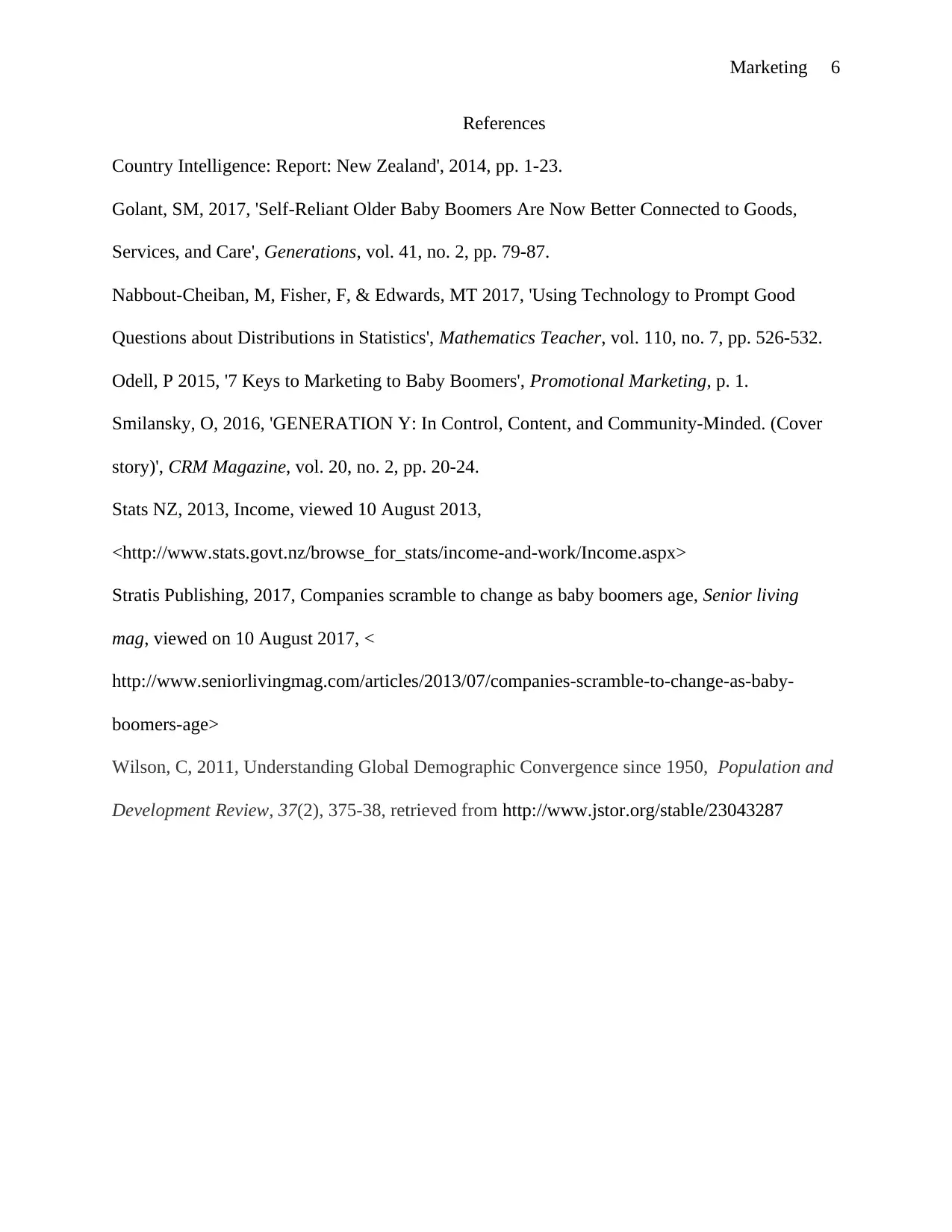
Marketing 6
References
Country Intelligence: Report: New Zealand', 2014, pp. 1-23.
Golant, SM, 2017, 'Self-Reliant Older Baby Boomers Are Now Better Connected to Goods,
Services, and Care', Generations, vol. 41, no. 2, pp. 79-87.
Nabbout-Cheiban, M, Fisher, F, & Edwards, MT 2017, 'Using Technology to Prompt Good
Questions about Distributions in Statistics', Mathematics Teacher, vol. 110, no. 7, pp. 526-532.
Odell, P 2015, '7 Keys to Marketing to Baby Boomers', Promotional Marketing, p. 1.
Smilansky, O, 2016, 'GENERATION Y: In Control, Content, and Community-Minded. (Cover
story)', CRM Magazine, vol. 20, no. 2, pp. 20-24.
Stats NZ, 2013, Income, viewed 10 August 2013,
<http://www.stats.govt.nz/browse_for_stats/income-and-work/Income.aspx>
Stratis Publishing, 2017, Companies scramble to change as baby boomers age, Senior living
mag, viewed on 10 August 2017, <
http://www.seniorlivingmag.com/articles/2013/07/companies-scramble-to-change-as-baby-
boomers-age>
Wilson, C, 2011, Understanding Global Demographic Convergence since 1950, Population and
Development Review, 37(2), 375-38, retrieved from http://www.jstor.org/stable/23043287
References
Country Intelligence: Report: New Zealand', 2014, pp. 1-23.
Golant, SM, 2017, 'Self-Reliant Older Baby Boomers Are Now Better Connected to Goods,
Services, and Care', Generations, vol. 41, no. 2, pp. 79-87.
Nabbout-Cheiban, M, Fisher, F, & Edwards, MT 2017, 'Using Technology to Prompt Good
Questions about Distributions in Statistics', Mathematics Teacher, vol. 110, no. 7, pp. 526-532.
Odell, P 2015, '7 Keys to Marketing to Baby Boomers', Promotional Marketing, p. 1.
Smilansky, O, 2016, 'GENERATION Y: In Control, Content, and Community-Minded. (Cover
story)', CRM Magazine, vol. 20, no. 2, pp. 20-24.
Stats NZ, 2013, Income, viewed 10 August 2013,
<http://www.stats.govt.nz/browse_for_stats/income-and-work/Income.aspx>
Stratis Publishing, 2017, Companies scramble to change as baby boomers age, Senior living
mag, viewed on 10 August 2017, <
http://www.seniorlivingmag.com/articles/2013/07/companies-scramble-to-change-as-baby-
boomers-age>
Wilson, C, 2011, Understanding Global Demographic Convergence since 1950, Population and
Development Review, 37(2), 375-38, retrieved from http://www.jstor.org/stable/23043287
⊘ This is a preview!⊘
Do you want full access?
Subscribe today to unlock all pages.

Trusted by 1+ million students worldwide
1 out of 6
Related Documents
Your All-in-One AI-Powered Toolkit for Academic Success.
+13062052269
info@desklib.com
Available 24*7 on WhatsApp / Email
![[object Object]](/_next/static/media/star-bottom.7253800d.svg)
Unlock your academic potential
Copyright © 2020–2025 A2Z Services. All Rights Reserved. Developed and managed by ZUCOL.





